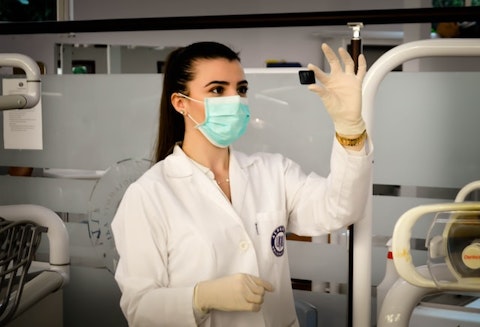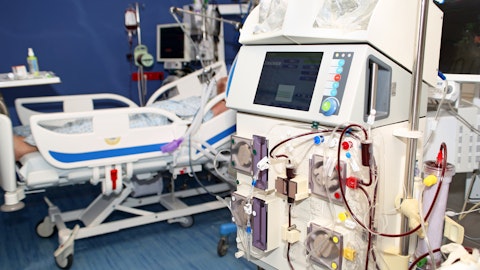OPKO Health, Inc. (NASDAQ:OPK) Q4 2022 Earnings Call Transcript February 23, 2023
Operator: Good day, and welcome to the OPKO Health Fourth Quarter 2022 Financial Results Conference Call. . I would now like to turn the conference over to Yvonne Briggs with LHA. Please go ahead.
Yvonne Briggs: Thank you, operator, and good afternoon. This is Yvonne Briggs with LHA. Thank you all for joining today’s call to discuss OPKO Health’s financial results for the fourth quarter of 2022. I’d like to remind you that any statements made during this call by management other than statements of historical fact will be considered forward-looking and as such, will be subject to risks and uncertainties that could materially affect the company’s expected results. Those forward-looking statements include, without limitation, the various risks described in the company’s SEC filings including the annual report on Form 10-K for the year ended December 31, 2022, and in subsequently filed SEC reports. The conference call contains time-sensitive information that is accurate only as of the date of the live broadcast today, February 23, 2023.
Except as required by law, OPKO undertakes no obligation to revise or update any forward-looking statements to reflect events or circumstances after the date of this call. Before we begin, let me review the format for today’s call. Dr. Phillip Frost, Chairman and Chief Executive Officer, will open the call. Dr. Elias Zerhouni, Vice Chairman and President of OPKO will then provide an overview of OPKO’s pharmaceutical business as well as BioReference Laboratories. After that, Adam Logal, OPKO’s CFO, and will review the company’s fourth quarter financial results, and then we’ll open the call to questions. Now I’d like to turn the call over to Dr. Frost.
Phillip Frost: Somatrogon are underway by our commercial partner, Pfizer. NGENLA is our once-weekly injectable growth hormone product developed to ease a patient’s burden versus the standard daily injections. Pfizer has launched the product in 15 countries, including Japan, Germany and the U.K. and expects to have launched in all priority markets by the end of the year. As I mentioned on our last call, NGENLA is starting to post significant sequential quarterly sales growth and Adam will review OPKO’s profit share and royalty payments in his prepared remarks. We believe Pfizer is making progress in the U.S. to advance NGENLA through the regulatory process and address the FDA’s comments. We continue to work with Pfizer as they stand by their commitment to commercialize NGENLA globally and we’ll provide further updates on its regulatory status in the U.S. and commercial progress in foreign countries.
As for our clinical diagnostics business, BioReference Laboratories is making significant progress in reducing costs and rightsizing the business. In parallel, BRL is expanding its portfolio by focusing on innovation and specialty testing segments, including oncology, women’s health and urology while driving growth with novel partnership arrangements. Elias will provide further details on the lab and it’s performance following his commentary on the pharmaceutical business. With that brief overview, I will now turn the call over to Elias. Elias?
Elias Zerhouni: Yes. Thanks, Phil, and good afternoon, everyone. I think it has been an eventful 2022 for OPKO and I’m looking forward to further progress in 2023 with quite a few significant milestones on the horizon. Let me start with the pharmaceutical business division where we have made significant progress at ModeX Therapeutics by first, enhancing our proprietary platform technologies known as MSTAR and STEALTH with 8 patents filed. These multi-specific antibodies provide flexibilities to go beyond 3 targets up to a total of 6. We believe MSTAR is a plug-and-play, flexible adaptive platform that optimizes functionality and manufacturing simplicity. We believe that this provides a competitive advantage over other multi-specific technologies.
In parallel, we have focused on advancing our portfolio significantly now containing 7 assets, 1 of which is in the clinic in Phase I and 5 in late preclinical stages with 3 of the 5 planned to enter the clinical stages by end of 2023 or beginning of 2024. For infectious disease, we continue to advance the development of a first-in-class EpsteinBarr virus nanoparticle vaccine. EBV infects up 95% of the global adult population during their lifetime and is associated with about 1% of all cancer cases worldwide. It also is the leading cause of infectious mononucleosis. Despite the virus’ prevalence, and its role in causing life-threatening diseases, there are currently no FDA-approved vaccines or treatments for EBV. Our vaccine leverages ModeX’s innovative biologics platform to target 4 major EBV proteins.
This multi-targeted approach improves upon previous efforts and holds potential to provide complete protection against EBV infection. The initial indication for this vaccine will be for infectious mononucleosis, but it’s ultimately intended for cancer prevention. Very much like the human papillomavirus HPV vaccines that protect against cervical cancer. EBV is associated with Burkitt lymphoma, nasopharyngeal carcinoma, certain gastric and other cancers. So it has the potential to prevent over 200,000 malignancies associated each year with this virus. And potentially, could be indicated for multiple sclerosis disease, now believed to also be associated with the EpsteinBarr virus. We also have a tri-specific candidate in Phase I clinical trials to treat HIV that has received funding from the NIH as well as 2 preclinical tri and tetra-specific candidates with increased potency that also target HIV.
We hope to investigate the potential for such multispecific antibodies to suppress virus replication after interruption of antiretroviral drug treatment. Such a therapy could potentially decrease the need for continuous drug treatments, whose multiple side effects cause secondary complications and decrease therapeutic compliance. In addition, we have several SARS-CoV-2, multispecific antibodies in late preclinical testing, partially funded by DARPA. These candidates potently neutralize all known circulating variants of the virus and may help to limit the continued spread of the virus. We’re particularly interested in exploring whether such antibodies could be used to protect subjects with weakened immunity, such as patients with cancer, diabetes, or asthma or autoimmune diseases.

Photo by Ani Kolleshi on Unsplash
There is also an interest in using such antibodies to treat long COVID, a complication of COVID infections. In oncology, we have 2 multi-specific multifunctional antibodies focused on hard-to-treat solid tumors and 1 focused on liquid tumors. These oncology programs are in the preclinical stage with the goal of entering the clinic in early 2024. We’ve also worked to make ModeX more visible to the outside world with a busy schedule presenting at several scientific meetings. In January, we presented at the Safety and Efficacy of Bispecific Antibodies, ADCs and Combination Therapy conference regarding our 3 specific antibody technology. On the 22nd of this month, we participated in the Keystone Symposia on molecular and cellular biology and presented a poster titled trispecific antibody targeting HER2 and T cells inhibiting breast cancer growth via CD4 cells.
In March, our team will be at the festival of biologicals presenting multi-specific targeting for the treatment of infections and cancer. Taken together, ModeX Therapeutics represents a fundamental change in the direction for OPKO, shifting the balance from diagnostics to therapeutics and offering innovative solutions to pressing unmet needs for cancer and viral disease prevention and treatment. And we will present a more complete view of our R&D portfolio on March 20, 2023. In addition, the pharmaceutical division is working to advance RAYALDEE for the correction of secondary hyperthyroidism a major complication of chronic renal disease and exploring new strategic partnerships to accelerate its commercial growth. We’re also exploring strategic partnerships to advance our programs in Alzheimer’s disease and and have supported as well during the past few months the response of Pfizer to the FDA for the approval of somatrogon.
Now I’d like to turn to our diagnostics segment and discussed by reference laboratories. Our continued priority is to return this business back to profitability post COVID. As such, we have been aggressively reducing costs and have reached our stated goal of eliminating approximately $140 million of annualized expenses since February 2022. We will continue our Reach initiative, which is designed to improve productivity and reduce costs which has touched every part of the organization, and we’re targeting more than an additional $30 million of reductions or about 5% of our expected spend in 2023. As I mentioned on our last call, we continue to focus on operational excellence, including revenue cycle management, while pursuing efficiencies in virtually every aspect of this business, including refocusing on our higher-margin products post COVID and geographic redeployment of our patient service centers with 11 new patient service centers opened so far and 13 less productive centers closed in 2022.
As we stabilize our core testing business, our higher-margin specialty testing segments continue to outperform. As Phil mentioned, these segments include oncology, women’s health, urology and special ventures. We’re focused on continuing to drive growth in these segments by bringing innovation to the portfolio. For example, within oncology, cancer genomics continues to be a strong growth area for GenPath with several new offerings in 2022. During the fourth quarter, we entered into partnerships with large academic centers such as University of Rochester and the University of Pittsburgh as examples. During the quarter, we also launched a new service for patients that previously received OnkoSight advanced NGS testing. Let me explain. Typically, oncologists order a reduced set of genetic markers specific to each cancer type, about 50.
However, BioReference has developed technology that is able to analyze simultaneously all 525 cancer relevant genetic abnormalities. The reanalysis of this comprehensive data set with our analytical software can help physicians who need to look beyond specific small panels to guide their therapy options. By reanalyzing the full genetic panel, it also enables oncologists to better assess the biology of the cancer in their patients and guide either therapy or as we found out, inclusion in relevant clinical trials offered by pharma or biotech company without the need for resequencing an area of great interest and also a new avenue for increased revenues. Our commercial footprint has expanded during the fourth quarter of 2022, with the addition of 8 new oncology sales territories as well as 5 new molecular oncology sales roles, who will focus on our cancer genomics offering in large cancer centers, health systems and large oncology practices.
In early 2023, we will be launching new testing to exclude the expanded OnkoSight portfolio and expanding also minimal residual disease portfolio following the very high demand by oncologists for this testing. In urology, we have expanded the commercial team with 5 new urology territories for 2023 growth as well as training and incentivizing our entire sales team on selling the 4Kscore test in all their call points in markets. During the fourth quarter, the urology team brought on 68 new accounts which have promising applications for a fast start to 2023 for growth. In women’s health, we continue to build strong relationships with our large practice groups, which continue to expand and create meaningful opportunities as we look forward to 2023.
In terms of innovation, in early 2023, we will be launching our new CINtec PLUS cytology testing, which allows physicians to identify women who are at high risk for the presence of cervical dysplasia and who need intervention versus a watch-versus-wait approach. Typically, this test applies to patients who have a negative or some dysplasia but positive HPV virus test. CINtec can then differentiate whether the HPV viruses are active and therefore, dangerous and could lead to the development of cancer and will require intervention rather than yearly or biyearly follow-ups. BioReference will be the first national reference lab with this offering. In terms of the clinical services and hospital services, we continue to expand our partnership with Westchester Medical Center and are commencing our efforts on their outreach business which will lead to growth as we head into the first quarter of 2023.
Additionally, we continue to expand our focus in the urgent care sector, expanding our existing relationships, bringing on 20 new offices in the fourth quarter of 2022 as well as establishing a new urgent care network in the Northeast. In Q4, we launched a new comprehensive respiratory panel that included the most common viral diseases for the fall of 2022, flu A and B, COVID and RSV. This provided an easy way for clients to order testing with 1 swab and identify which potential virus they needed to treat. This was very well received in the marketplace as we were one of the first national labs to launch this type of panel. We’ve also expanded our hospital team, focused on new business for 2023 and expanded our clinical team with roles focused on retention of our current business and minimizing attrition.
In summary, our vision for BRL is to move BioReference back to profitable growth following the drastic reduction in COVID revenues experienced by the entire industry. And to do so as soon as possible during 2023. I’m very hopeful that these efforts will be apparent to you in the second and third quarter. And I will now turn the call over to our CFO, Adam Logal.
Adam Logal: Thank you, Elias. Starting with our pharmaceutical segment. Revenues for the 3 months ended December 31, 2022, were an increase of $7.4 million from the comparable period of 2021. Total costs and expenses for the 2022 quarter were $67.9 million, including $16.5 million of noncash intangible amortization. Research and development expenses were $16.6 million, which is consistent with the fourth quarter of 2021. Operating loss from our pharmaceuticals segment was $22 million for the fourth quarter compared to an operating loss of $14.8 million for the prior year quarter. The increase in losses reflects the amortization of our intangible assets upon the approval of NGENLA earlier in 2022. Moving to our diagnostics segment.
We reported revenue for Q4 of 2022 of $139.4 million compared to $362.8 million for the 2021 period. This decline reflects lower COVID testing volumes as the market shifted to rapid at-home testing earlier this year. We continue to execute our Reach expense reduction program, as Elias mentioned. We’ve reduced our expense run rate by over $140 million and realized benefits from this program in each sequential month during the quarter. As Elias mentioned, we have identified a number of near- and medium-term growth programs that we expect to realize in the first half of 2023, which will help return BioReference to profitable growth. Operating loss for our diagnostics segment was $23.3 million for the quarter, which reflects a sequential improvement of approximately $26.4 million.
In the fourth quarter of 2021 and we reported an operating loss of approximately $18.6 million. Turning to the consolidated financial results for the quarter. We reported an operating loss of $55.3 million compared to Q4 2021 operating loss of $63.1 million. Net loss for the fourth quarter of 2022 included a $49.1 million noncash mark-to-market adjustment reflecting the decline in value of our equity holdings in GeneDx, formerly Sema4, partially offset by an income tax benefit of $17 million, resulting in a net loss of $85.2 million or $0.11 per share for the quarter. This compares to a net loss of $73.8 million or $0.11 per share for the 2021 period. As we look at the gearing quarter ahead, we are providing financial guidance with the following assumptions.
For our pharmaceuticals segment, because the timing is not certain, we have not assumed the approval of NGENLA by the U.S. FDA in our forecast. Approval would result in a milestone payment of $90 million. We have also not assumed the U.S. region for NGENLA will be in the gross profit share. We also have assumed beginning in Q2 2023 that the EU region will shift to a gross profit share from the royalty structure currently in place. We assume Vifor will receive pricing determinations and will launch RAYALDEE in additional EU territories thereby triggering a $7 million milestone payment likely in the first half of 2023. We assume a stable FX rate for our ex U.S. pharmaceutical business as we have seen a 10% impact on our business over the last 12 months.
For our diagnostics segment, we assume COVID testing volumes will continue to decline throughout 2023, and we have assumed modest growth in core testing volumes with stronger growth in our higher-margin oncology, women’s health and urology specialty lines of testing. We’ve also assumed the full impact of our Reach program, delivering an additional $30 million of cost savings in 2023 or more than 5% of our total diagnostic spend. Due to the significant variables in our revenue and spending plans outlined, we have limited our outlook to the first quarter and look forward to providing additional updates during our first quarter conference call. For the first quarter of 2023, we expect the following: total revenues between $165 million and $185 million, with revenue from services between $130 million and $140 million; revenue from product sales between $30 million and $35 million and other revenue between $5 million and $10 million.
We expect Q1 2023 costs and expenses to be between $230 million and $245 million including R&D expense between $20 million and $24 million and depreciation and amortization expense of $25 million. As we progress through 2023, we expect to enter into at least 1 non-dilutive licensing transaction for 1 of our early-stage programs that Elias described. We will manage our investments in new R&D programs and commercial initiatives to our available cash resources. That concludes our prepared remarks. Thank you for your attention. And now operator, let’s open the call for questions. Operator?
See also 10 Largest Economies in Europe and 25 Biggest Connecticut Companies and Stocks.
Q&A Session
Follow Opko Health Inc. (NYSE:OPK)
Follow Opko Health Inc. (NYSE:OPK)
Operator: . The first question comes from Maury Raycroft with Jefferies.
Kevin Strang: This is Kevin on for Maury. Congrats on the update. I just had a first one on somatrogon. Is there any granularity you can say about what sort of update we could expect this year from Pfizer? And would this likely be a resolution either way? Or could it be a status update? And then on timing, could this be a midyear update? And what are some of the drivers behind potential time lines there?
Steven Rubin: This is Steve Rubin. We do expect some form of definitive communications from the FDA around NGENLA. So obviously hoping for by midyear, but I can’t guarantee when that will be, but we do expect that to be a definitive yes or no at that point.
Kevin Strang: Okay. Great. And then a quick question for Adam. You mentioned you expect to shift to gross profit share in Europe. And I think — I believe 2023, is there any granularity on when that could be and what the gating factors are there to that shift?
Adam Logal: Kevin, yes, so we expect — what requires in the European region to move to gross profit share is for the — for us to get pricing in 2 additional major markets. We have pricing in Germany. There’s — the other major markets are expected to launch this year. We’ve guided that we expect them in the first half of this year and in Q2 for the territory to shift to gross profit share.
Kevin Strang: Okay. Great. And just a last one for Elias on maybe the ModeX pipeline, just the types of deals or partnerships that you’re looking to make there and when we might see an update in that regard potentially this year?
Elias Zerhouni: So it depends on each product. And in terms of the portfolio. We’ve had a lot of incoming interest, both for the multispecific antibodies as well as the vaccine. So we’re in active conversations. I hope to see 1 or maybe 2 transactions complete this year, hopefully, in the first half. The structure of it is pretty classic. In other words, upfront plus milestones cash royalties, and this is the dominant type of transaction we’re looking for. Others are looking for more long-term collaborations and that can be variable depending upon the scope of the collaboration. But we will also keep some products and attempt to develop them with our own resources because they’re very, very valuable.
Operator: The next question comes from Jeffrey Cohen with Ladenburg Thalmann & Company.
Jeffrey Cohen: So I guess to start, Adam, any commentary generally speaking, on the margins, which were better than we thought, any pull-through? It looks like you’re balancing back a little on a linear basis?
Adam Logal: Yes. So there’s a couple of things that obviously, the Reach program had its biggest impact during Q3. So we saw a full quarter of the Q3 exits and reductions that we expected to see. So that was one of the drivers. We also received a $2.5 million payment on the pharmaceutical side of our business from our Chinese partner for the commercialization or development activities that are ongoing in China for RAYALDEE. So those are the 2 main drivers, Jeff.
Jeffrey Cohen: Okay. Got it. And I guess next, Elias, could you talk a little further about this urgent care network and the number of facilities, where they’re located, what a typical facility looks like as far as size and scope.





